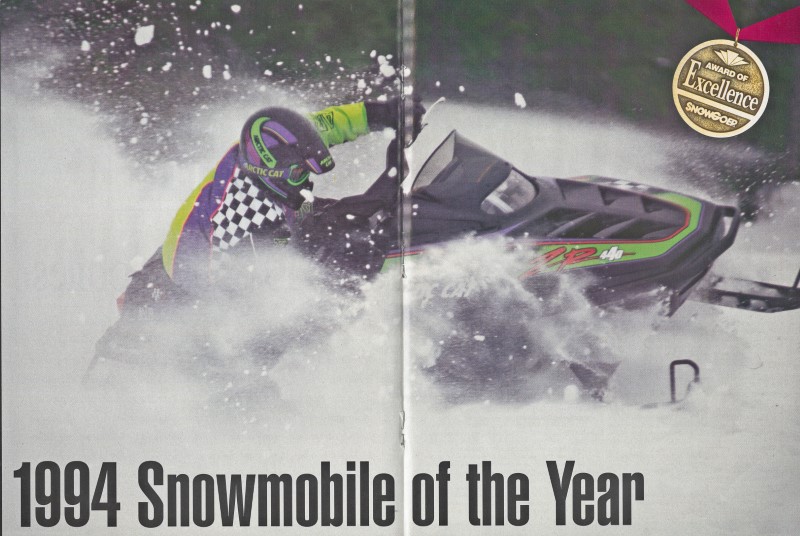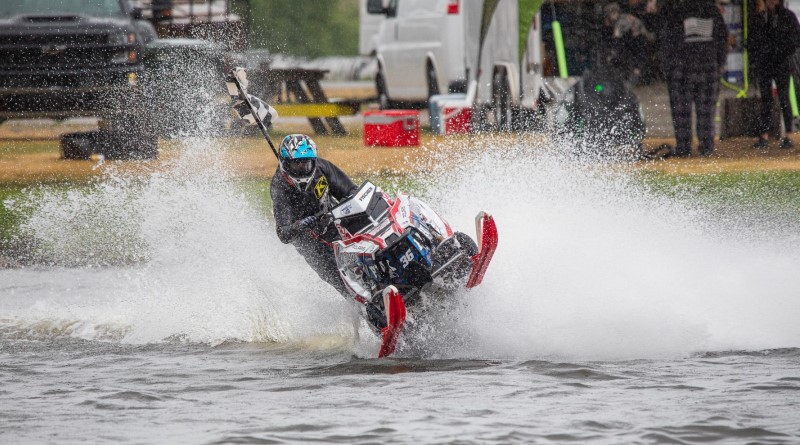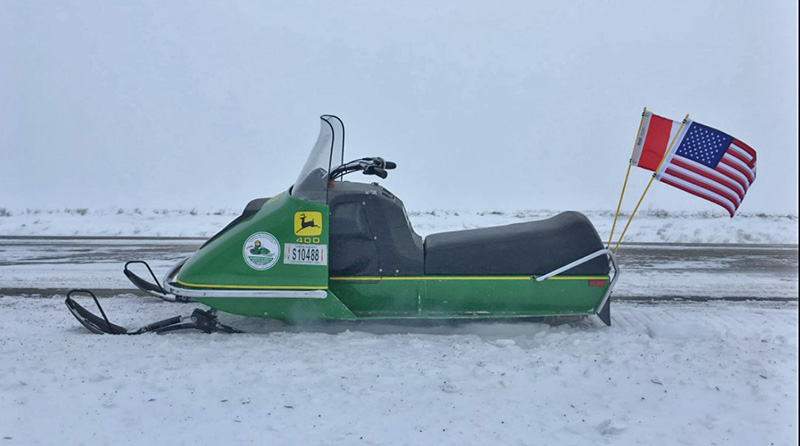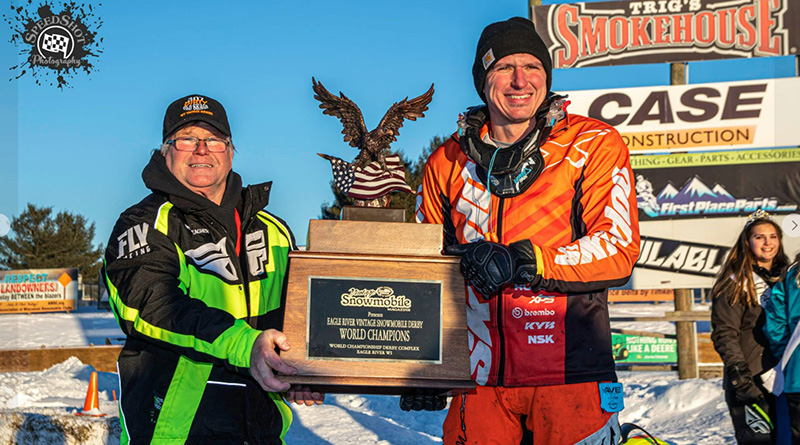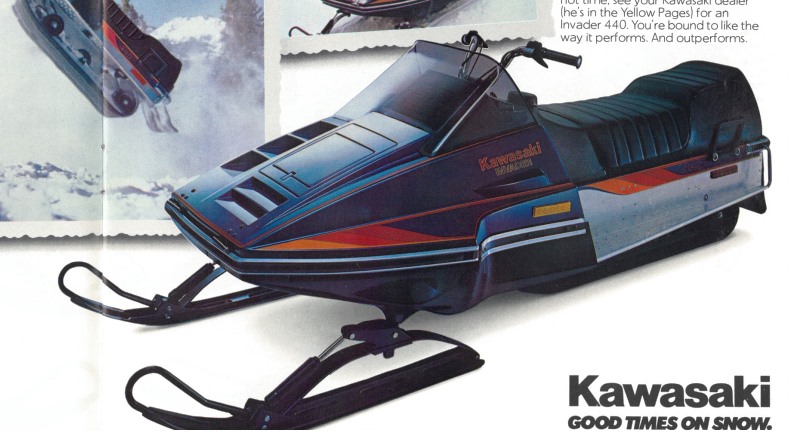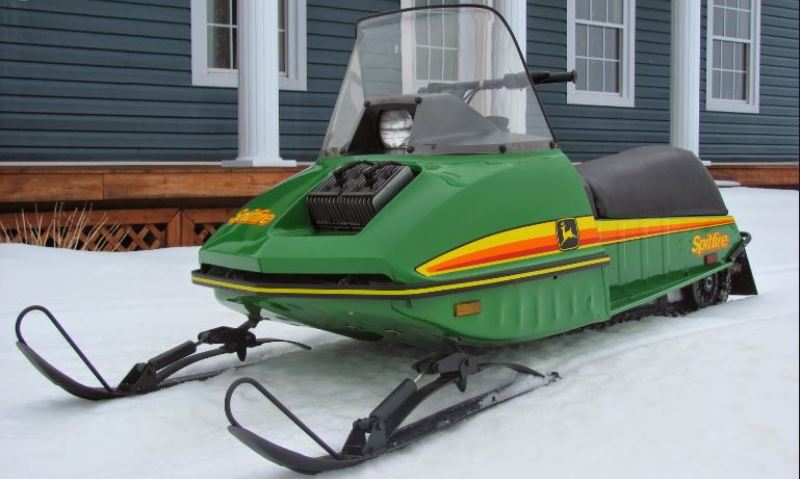 Some of the snowmobiles that we’ve tested we only see once a year—at the spring tests. The John Deere Cyclone 340, however, we got to know about as well as any owner would ever know it.
Some of the snowmobiles that we’ve tested we only see once a year—at the spring tests. The John Deere Cyclone 340, however, we got to know about as well as any owner would ever know it.
And, we can recommend the Cyclone exactly the same reasons that your neighbor down the street, who already owns one, would recommend it. First, the machine is visually exciting, drawing extensively from the styling of the 340-S endurance racer of two seasons ago. Second, it is built with Deere’s full integrity which means that it sports solid quality from the ski tips to the rear bumper. Thirdly, the 1977 John Deere Cyclone 340 is a performer in the family category of snowmobiles.
After having tested the introductory cyclone two springs ago, Snow Goer’s test staff concluded that the 1976 was one of the “best all-around” snowmobile buys. After running the 1977 version through its paces in Grand Portage, Minn., last spring, we can state that the Cyclone still remains one of the “best buys” in snowmobiling. But, it was the 1000-mile torture run through which we put a ‘76 Cyclone 340 just a month after the unveiling of the ‘77 machines that sealed our verdict.
The ‘76 Cyclone 340 that was one of three stars in the 1000-mile endurance test at Ironwood, Mich., came through the ordeal needing only a replacement of wear bars, a drive belt, and, because we didn’t install a set of $19.95 wear clips for the unexpected mud-slush-marginal conditions, where you run 99 percent of the time on snow, the track would have survived in fine style. Without the wear clips, which Deere dealers encourage for sleds that are used in marginal snow conditions, the friction from sand and mud created excessive heat between the hyfax runners and the grouser bars. But we gleaned an excellent insight into the John Deere track replacement policy. Had we been normal consumers, Deere’s policy would have resulted in a 40 percent discount for the replacement unit. Even into the second year of snowmobile ownership, you still receive a 25 percent discount on a new track.
Yet, through the rugged miles, the cyclone didn’t even burn out a set of spark plugs. The entire heart of the cyclone, its 339 cc John Deere/Kioritz fan-cooled twin, remained steady and sure. But, to keep it running even better this season, Deere’s engineers have installed an improved CD system to assure cleaner burning of the gas to oil mix.
Deere’s engineering and design staff didn’t stop with just an update of the ignition system. Other engine and powertrain related improvements include: a new aluminum base plate and tougher engine mounts to reduce flexing, and a new method of alignment of engine and drive system, and now the ability to use regular fuel.
Still, the powerplant remains essentially unchanged from last year’s design. You are still going to get the performance-oriented John Deere/Kioritz twin with reed valve induction and fan-cooling. A single Mikuni 34 mm carburetor is tied into the Deere-designed intake air box silencer. At the exhaust side of the twin is an ACS-built, John Deere designed one-piece expansion chamber with single resonator pipe that helps boost engine performance over a broad power band for best overall trail performance.
To help the John Deere/Kioritz deliver full potential is the job of the Deere- Comet clutching system, which has ‘been recalibrated for improved performance. The driven unit is entirely Deere’s. The driven features a reverse cam design which enables the cross shaft drive to be placed lower in the engine bay for a low center of gravity. Another advantage of Deere’s secondary clutch design is that a twist of the cam inward allows you to quickly remove the drive belt, a benefit on cold winter days.
Power for the 1977 John Deere Cyclone 340 goes through the cross shaft to the chain-case which has an improved sealing and venting system. The self- adjusting tensioner has also been revamped, again for more durability, and to insure that you get more power to the track.
Putting down a footprint that measures 15½ inches in width by 39 inches of on-snow length, the track is a full cleated, molded-in grouser bar design. The suspension, proven in cross country racing over the past few winters, is a dual shock/tension spring arrangement with forward and aft adjustment for terrain and driver weight. In addition, there is a separate adjustment on the front pivot shaft to increase or decrease ski lift to match snow conditions. Essentially unchanged from last season’s slide rail design, the unit was impressive during the 1000-mile endurance run with the ‘76 Cyclone.
Ski stance measures 32 inches from center-to-center. Holding the skis tight in the turns is the job of the four-leaf springs which is a change from last year’s mono-leaf shock arrangement.
Overall steering is precise and steady, never leaving you any doubt as to who is in control, at any speed.
And, at speed, the 1977 John Deere Cyclone 340 comes readily into its own. By carving dead weight from the Cyclone, Deere has made the sled more fun, as the machine actually feels lighter in turns and over rough trail.
Weight reduction was no accident. Improved quality control techniques in areas like better controlling of the amount of hood material poured into the molds, made an immediate difference of five pounds. Other weight reducing techniques included: replacing the previously steel belt guard with an aluminum one; changing the hood support, which is both lighter and more convenient; installing aluminum base plates; and, switching to a lighter gage metal in the bumper assembly. All of these weight saving measures were done, state Deere spokesmen, without reducing the sled’s reliability.
One of the benefits of the Cyclone is the sure-gripping disc brake, which is mounted on the recoil start side of the cross shaft. If you think you’re going to get into trouble, slam on that mechanical unit, because it locks the track in nothing flat.
Quality-built, unabashedly reliable, and plain fun to ride, the And, at speed, the 1977 John Deere Cyclone 340 comes readily into its own. will fit into the plans of any snowmobiling family.
The 8-gallon gas tank is ample for a good day’s ride. And other styling and safety-oriented features for ‘77 are designed to make the sled fit you, not vice versa. For example, there is a rear bracket to prevent damage to the snow- flap; a rear lift handle for convenience in loading and unloading the sled; and, an anti-rattle rubber bumper between the muffler and frame. And, to prevent fuel from flooding the crankcase during trailering, Deere has even added a fuel shut-off in the gas line. This prevents the float bowl carb, which tends to move up and down during travel, from actually “pumping” raw gas into the engine.
Last season, Deere introduced the Cyclone and we found it to be a quality, fun machine well-suited for family riding. But, this year, there is the advantage of detail improvements which make a good machine even better. You may not notice the little things on the ‘77 Cyclone, but, then, if the Deere designers have done their job right, you shouldn’t. The Cyclone belongs to the new generation of snowmobiles that is built to be bought because you like to ride, not because you like to play mechanic.

